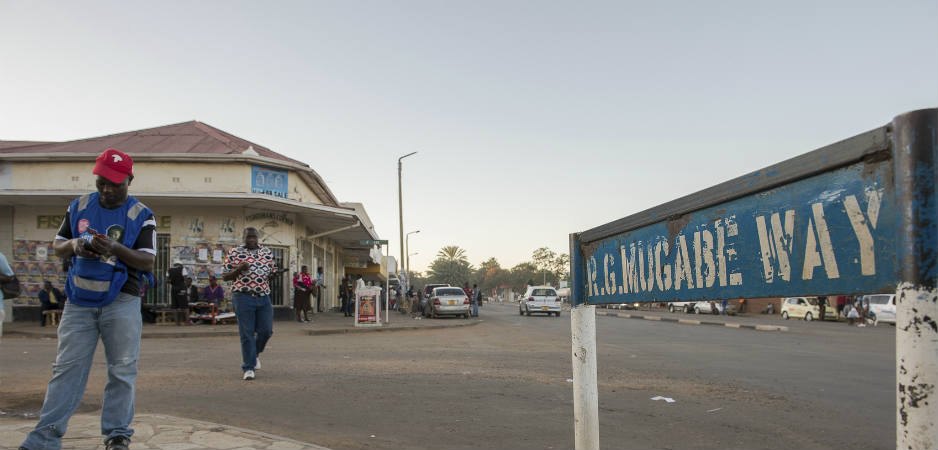With the economy in free fall and battling a rising tide of protest, Zimbabwe’s ruling party is in crisis.
Zimbabwe is facing a transition, but the outcome remains unclear. For months, the state has been battling a rising tide of protests and “stay-aways” prompted by economic collapse and poor management of the budget. The once-formidable opposition has finally found its unity following a decade of fractiousness, while the ruling ZANU-PF descends into factionalism and rivalry around the battle to succeed nonagenarian President Robert Mugabe at the helm of the kleptocratic state.
Balancing on the verge of economic collapse for over a decade, the Zimbabwean economy faltered in the early 2000s, recovered briefly (albeit from a low base) following dollarization in 2009 and has again hit the skids as it faces a biting liquidity crisis and foreign currency shortfall, leaving the country unable to pay its foreign and domestic debts. The International Monetary Fund (IMF), the World Bank (WB) and the African Development Bank (ADB) have been poised to intervene, but in June Zimbabwe failed to make its own deadline for paying back $1.8 billion in arrears—a debt that must be cleared before the country can access crucial funds to restart its economy.
Liquidity Crunch
Unemployment levels are estimated to be significantly over 90%, with the vast majority of the country’s citizens engaged in work in the informal sector—predominantly small-scale cross-border trade—or reliant on remittances from family members working in South Africa, the United States or the United Kingdom. In spite of the low levels of employment, 96.8% of the country’s budget is spent on salaries—a massively inflated public sector wage bill that is believed to be filled with ghost workers whose salaries form an important source of patronage for state insiders.
The liquidity crunch was prompted by a decline in foreign direct investment, disappearing diamond revenues, collapse of domestic production, externalization of funds by political elites and a growing trade deficit for the import-dependent country. As the government struggled to address these challenges, the population became ever more desperate, caught in the midst of the worst drought in 35 years.
In early 2016, the Reserve Bank governor announced the introduction of bond notes—a replacement currency to be pegged at 1:1 to the US dollar and paid out in lieu of dollars. Fearing the return of the hyperinflation experienced during the mid-2000s crisis, the announcement prompted a small wave of protests and skirmishes as well as a run on the banks as citizens tried to withdraw their funds to prevent their life savings being converted into a currency that isn’t recognized outside of Zimbabwe.
Anger and Desperation
The frustration, anger and desperation caused by an economic crisis exacerbated by government inaction has led to the most sustained period of protest seen in the country for 20 years. The protests have been a long time coming, beginning with the one-man protest by activist Itai Dzamara, who has since gone missing in March 2015 after being forced into an unmarked vehicle. In April 2016, a pastor’s desperate Facebook video with the hashtag #ThisFlag prompted a Twitter and Facebook storm, pushing social media into direct confrontation with the state.
But rather than driving the protests, the social media campaign merely capitalized on existing frustration, broadening and extending the narrative. On July 1, protests erupted at the border between Zimbabwe and South Africa after the government banned the importation of a number of key goods in a bid to address the trade deficit. Three days later, violence erupted in downtown Harare as minibus operators protested against police harassment and the imposition of hefty new fines that would negatively affect public transport operators. Police responded with teargas and beatings, prompting outrage from civil society and the media.
On July 6, the first of three #ShutdownZimbabwe events occurred, as workers across the country stayed away, businesses remained shut and the streets deserted. The protest was initiated by unpaid civil servants, backed by the infamous war veterans and publicized by civil society bodies. The Zimbabwean government shut down the internet as it tried to undermine communication between groups of activists.
Videos and images of beatings of citizens by police circulated soon after the event. Since July 6, there have been weekly protests by various groups which have been met with increased hostility and violence by an ever more desperate government. The state has imprisoned hundreds of activists, with more than 70 currently still in custody, including prominent activist from the #Tajamuka movement, Promise Mkwananzi.
Violence and Bribes
Having once been lauded as one of the most effective and widely-supported opposition parties on the continent, the Movement for Democratic Change (MDC) suffered a series of public spats and splits in 2013 that left it weakened, and many of its leaders discredited.
 Fair Observer provides you deep and diverse insights for free. Remember that we still have to pay for servers, website maintenance and much more. So, donate now to keep us free, fair and independent.
Fair Observer provides you deep and diverse insights for free. Remember that we still have to pay for servers, website maintenance and much more. So, donate now to keep us free, fair and independent.
However, in light of the MDC president’s failing health and a sense of possibility engendered by ruling party divisions and mass discontent, Zimbabwe’s opposition politicians appear to have papered over their differences. The country’s fractured opposition and former ZANU-PF heavyweights have coalesced, creating a grand coalition called NERA—the National Election Reform Agenda—comprised of 18 parties, whose mass march on August 26 was violently repressed despite a court ruling that it could go ahead.
Members of civil society, the academic community and opposition groups have called for a transitional authority to take power from the faltering ZANU-PF elite, as a temporary governing mechanism to rebuild the state ahead of fresh elections.
The Zimbabwean government is on the back foot. Fighting battles on all sides, the ruling party has been unable to secure the necessary funds to buy its way out of the crisis. Instead, they have resorted to violence and bribery to try to quell the rising tide of the disaffected.
In addition, ZANU-PF is riven by internal factionalism as the declining health of 92-year-old President Mugabe, and external pressure injects a sense of urgency into the realignment of factions. “Team Lacoste,” the faction backing donor-favorite Emmerson Mnangagwa, has suffered significant purges in both government and the party, making it difficult for him to inherit Mugabe’s mantle. G40—or Generation 40—the faction behind President Mugabe’s wife, Grace Mugabe, is seen to be able to control the purges, as it has a majority in the ruling party’s national disciplinary committee.
Personal Loyalties
Historically, Mnangagwa has been able to count on support from sections of the country’s security forces, but that support isn’t guaranteed. Although personal loyalties may remain at the upper levels, there are rumblings of dissent from the lower ranks. Though their salaries have always been prioritized, the state has found it increasingly difficult to pay the military.
In late August, there were reports by South African media outlets that members of the police and military have joined the protests in response to unpaid salaries and the deepening economic crisis. State media responded to this by alleging that opposition parties were responsible for having fake uniforms imported into the country in order to cause confusion.
On September 1, the day before a scheduled NERA rally, the government issues an unconstitutional ban on all protests in Harare for a two-week period. In response, state media reported that the ruling party was considering amending the 2013 constitution to prevent future protest action.
It’s uncertain what impact these moves by the state might have, but it seems unlikely that they will be able to quell the wave of popular protest through legislation alone. For now, Zimbabwe is at a crossroads and the state has too little money to be able to either repress dissenters or buy supporters. This presents an opportunity for the opposition, but it’s unclear as to whether or not they have a workable strategy for a post-Mugabe political dispensation. For the average Zimbabwean, it is clear that there are difficult times ahead and the road to economic recovery is likely to be long and arduous.
The views expressed in this article are the author’s own and do not necessarily reflect Fair Observer’s editorial policy.
Photo Credit: Sproetniek
Support Fair Observer
We rely on your support for our independence, diversity and quality.
For more than 10 years, Fair Observer has been free, fair and independent. No billionaire owns us, no advertisers control us. We are a reader-supported nonprofit. Unlike many other publications, we keep our content free for readers regardless of where they live or whether they can afford to pay. We have no paywalls and no ads.
In the post-truth era of fake news, echo chambers and filter bubbles, we publish a plurality of perspectives from around the world. Anyone can publish with us, but everyone goes through a rigorous editorial process. So, you get fact-checked, well-reasoned content instead of noise.
We publish 2,500+ voices from 90+ countries. We also conduct education and training programs
on subjects ranging from digital media and journalism to writing and critical thinking. This
doesn’t come cheap. Servers, editors, trainers and web developers cost
money.
Please consider supporting us on a regular basis as a recurring donor or a
sustaining member.
Will you support FO’s journalism?
We rely on your support for our independence, diversity and quality.






